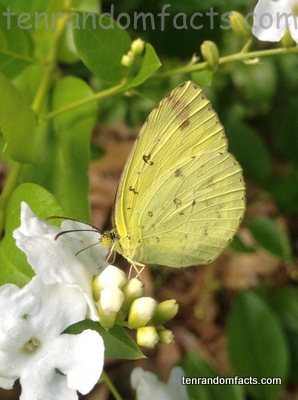Flutter around, dance around.
- Common Grass Yellow butterflies are commonly know as ‘Common Grass Yellows’ and are also known as ‘Large Grass Yellows’ or ‘Grass Yellows’.
- Common Grass Yellow butterflies are small to medium butterflies that are found in Africa, Asia, South Pacific islands and Australia.
- Common Grass Yellow butterflies are from the family ‘Pieridae’, a family that has mainly white, yellow and orange butterflies, sometimes with black spots.
- Common Grass Yellow butterflies are bright lemon yellow in colour, and have black markings at the tips and borders of the butterfly’s wings and a narrow black band on the hind wing, and the underside of the wings are paler yellow with brown speckles.
- Common Grass Yellow butterflies lay tiny white eggs that hatch, and become green caterpillars that grow to 24 – 30 mm (0.95 – 1.2 inches) in length, and then become smooth green pupae.
- The scientific name of the Common Grass Yellow butterfly is ‘Eurema hecabe’, and they have a wingspan of 35 to 45 mm (1.4 to 1.8 inches).
- Common Grass Yellow butterflies like to fly quickly, close to the ground, are found in open grassy or bushy terrain, hence their name.
- Common Grass Yellow butterfly larvae feed on a variety of plants, depending on the region, although they often include plants from Euphorbiaceae, the family of spurges, and Fabaceae, the family of legumes, peas and beans.
- Common Grass Yellow butterflies have different colouration in their wings depending on the season, known as ‘seasonal polyphenism’, resulting in generally darker wing colours in summer.
- Common Grass Yellow male butterflies are often seen in large groups, and the females usually fly about by themselves to find nectar from a wide variety of plants.






Good information. Thanks.